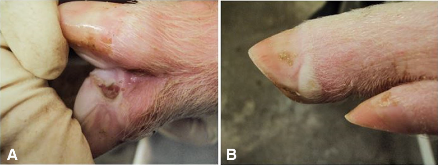Dexamethasone treatment did not exacerbate Seneca Valley virus infection in nursery-age pigs
- Oak Ridge Institute for Science and Education and National Animal Disease Center, Ames, IA (United States)
- College of Veterinary Medicine, Iowa State University, Ames, IA (United States)
- National Animal Disease Center, Agricultural Research Service, Ames, IA (United States)
Background: Senecavirus A, commonly known as Seneca Valley virus (SVV), is a picornavirus that has been infrequently associated with porcine idiopathic vesicular disease (PIVD). In late 2014 there were multiple PIVD outbreaks in several states in Brazil and samples from those cases tested positive for SVV. Beginning in July of 2015, multiple cases of PIVD were reported in the United States in which a genetically similar SVV was also detected. These events suggested SVV could induce vesicular disease, which was recently demonstrated with contemporary US isolates that produced mild disease in pigs. It was hypothesized that stressful conditions may exacerbate the expression of clinical disease and the following experiment was performed. Two groups of 9-week-old pigs were given an intranasal SVV challenge with one group receiving an immunosuppressive dose of dexamethasone prior to challenge. After challenge animals were observed for the development of clinical signs and serum and swabs were collected to study viral shedding and antibody production. In addition, pigs were euthanized 2, 4, 6, 8, and 12 days post inoculation (dpi) to demonstrate tissue distribution of virus during acute infection. Results: Vesicular disease was experimentally induced in both groups with the duration and magnitude of clinical signs similar between groups. During acute infection [0–14 days post infection (dpi)], SVV was detected by PCR in serum, nasal swabs, rectal swabs, various tissues, and in swabs from ruptured vesicles. From 15 to 30 dpi, virus was less consistently detected in nasal and rectal swabs, and absent from most serum samples. Virus neutralizing antibody was detected by 5 dpi and lasted until the end of the study. Conclusion: Treatment with an immunosuppressive dose of dexamethasone did not drastically alter the clinical disease course of SVV in experimentally infected nursery aged swine. A greater understanding of SVV pathogenesis and factors that could exacerbate disease can help the swine industry with control and prevention strategies directed against this virus.
- Research Organization:
- Oak Ridge Institute for Science and Education (ORISE), Oak Ridge, TN (United States)
- Sponsoring Organization:
- USDOE
- Grant/Contract Number:
- AC05-06OR23100
- OSTI ID:
- 1494687
- Journal Information:
- BMC Veterinary Research, Vol. 14, Issue 1; ISSN 1746-6148
- Publisher:
- BioMed CentralCopyright Statement
- Country of Publication:
- United States
- Language:
- English
Web of Science
Persistent Infection and Transmission of Senecavirus A from Carrier Sows to Contact Piglets
|
journal | August 2019 |
Similar Records
Absence of clinical disease and contact transmission of HPAI H5NX clade 2.3.4.4 from North America in experimentally infected pigs
Characterization of Senecavirus A Isolates Collected From the Environment of U.S. Sow Slaughter Plants




